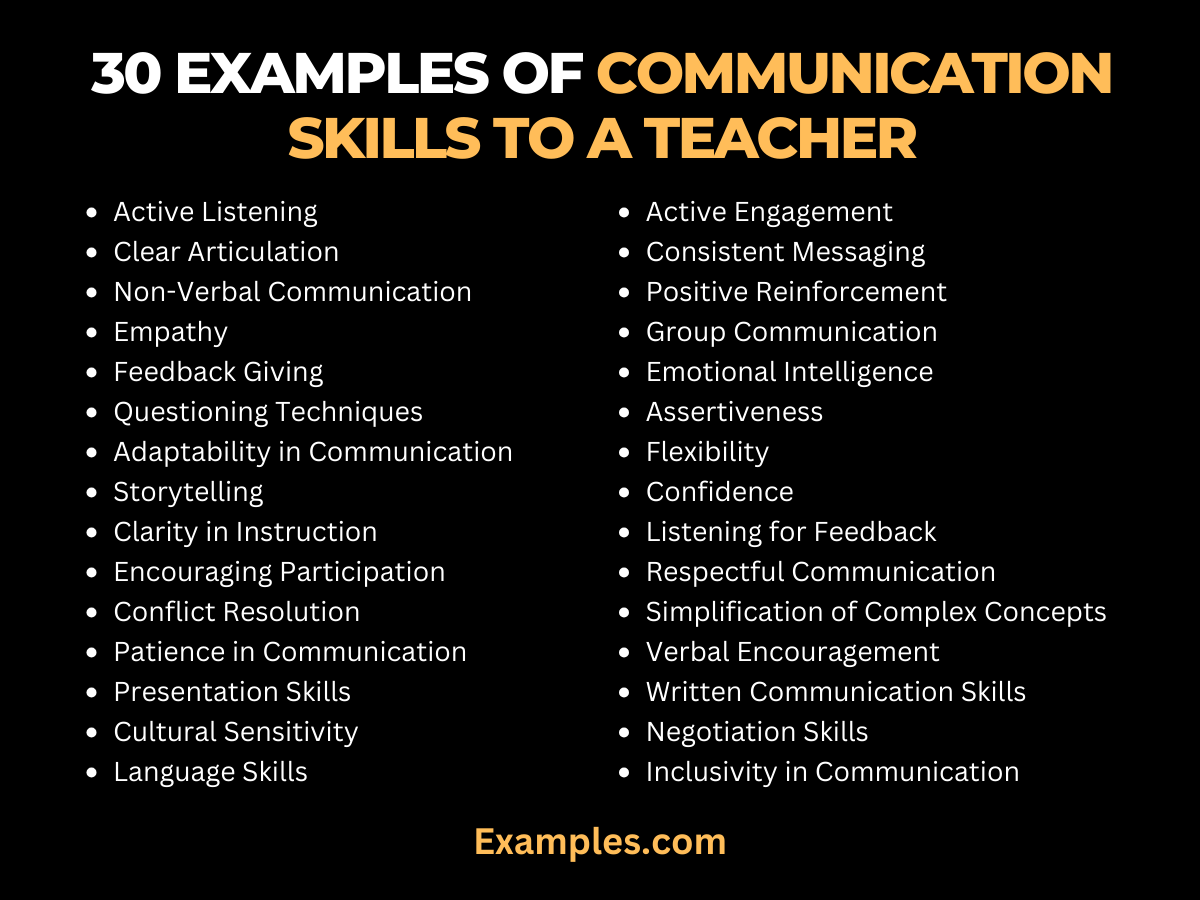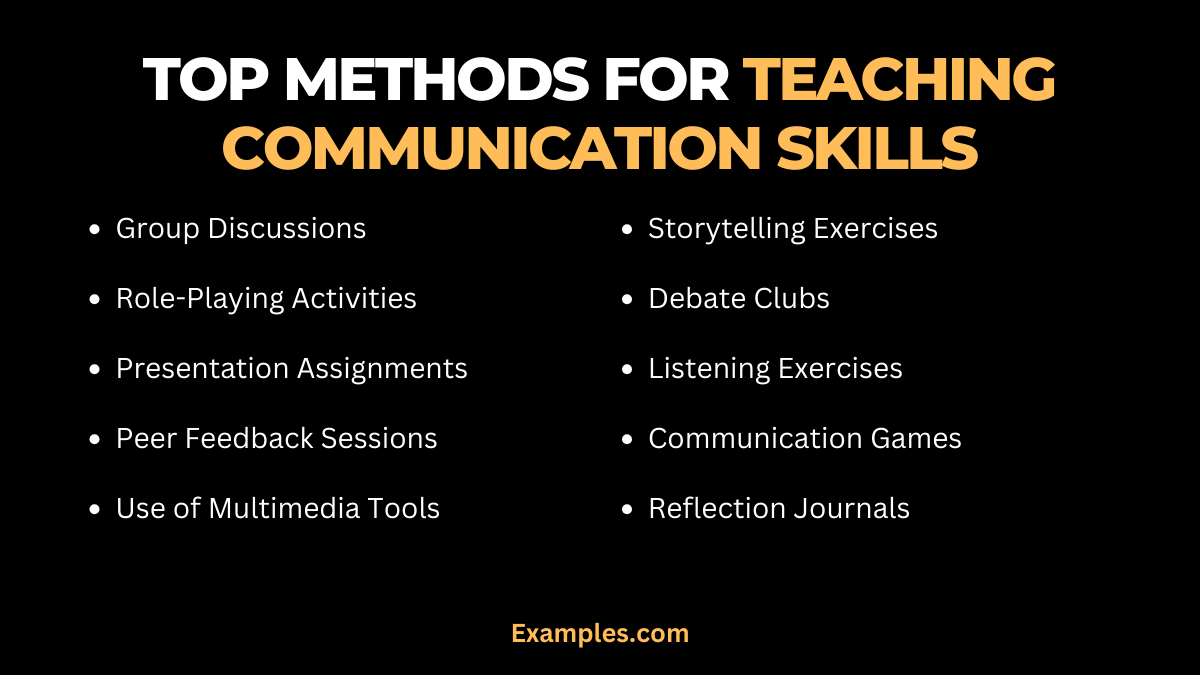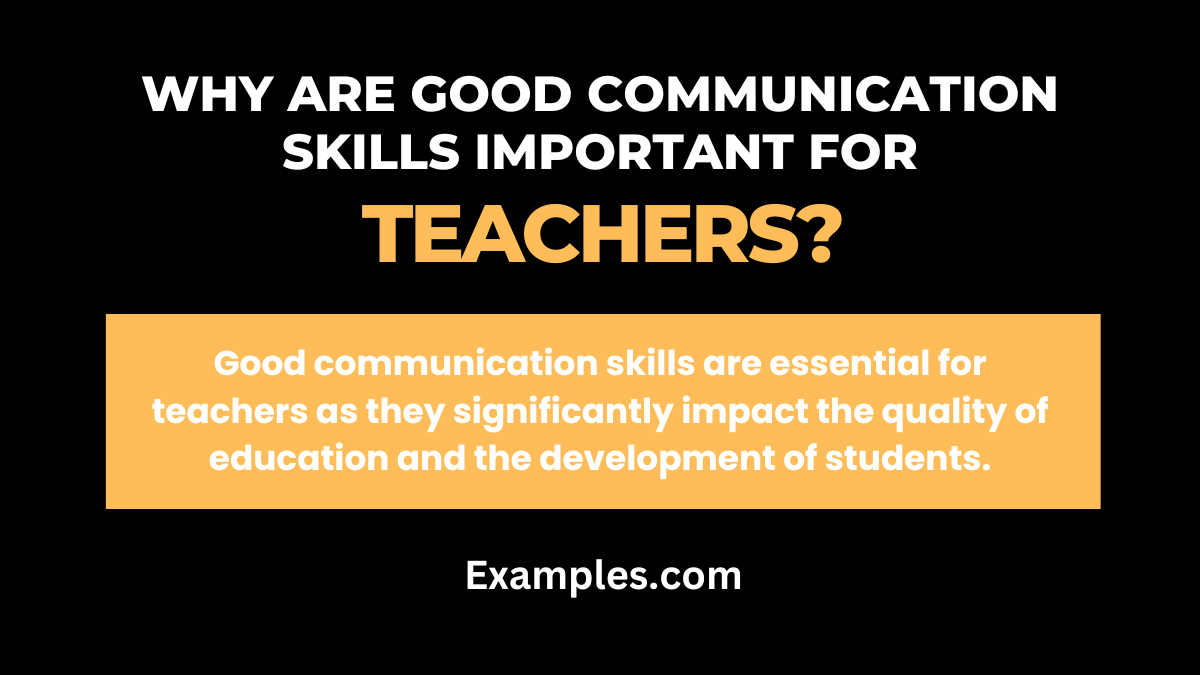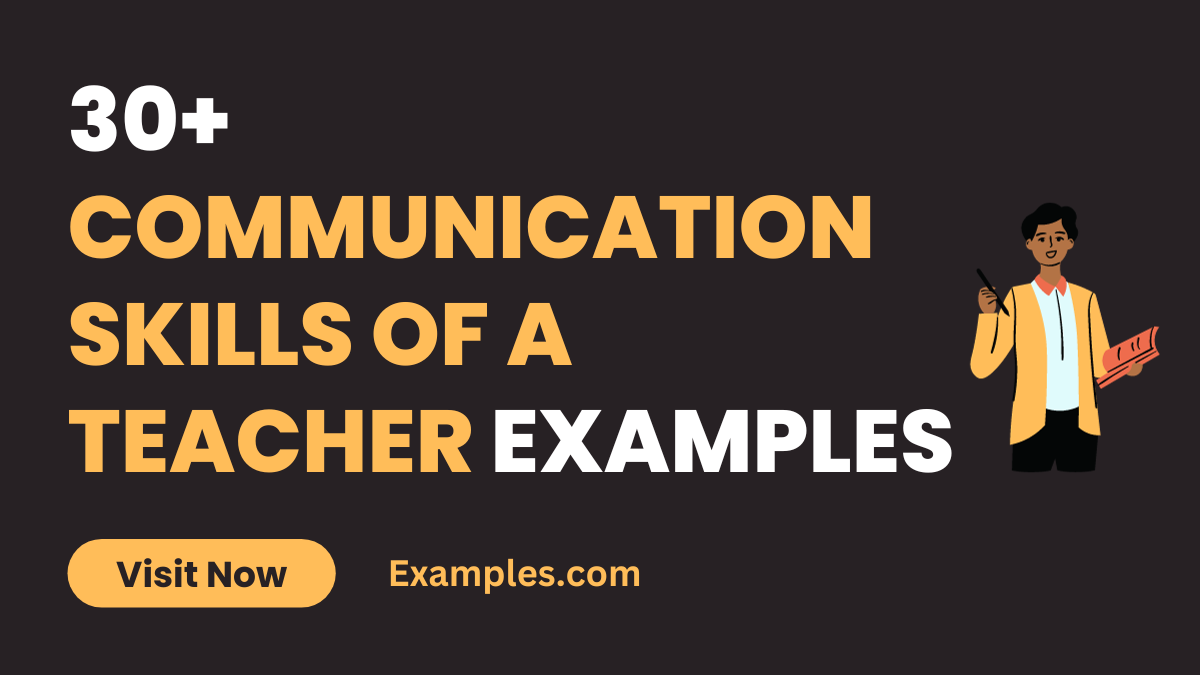29+ Communication Skills of a Teacher Examples
In the dynamic world of education, a teacher’s communication skills are crucial for fostering effective learning and student engagement. This comprehensive guide delves into the communication skills of a teacher, providing real-world communication examples to illustrate key concepts. From creating a positive classroom environment to effectively conveying complex ideas, these skills are instrumental in shaping the educational experience. Explore insightful strategies and practical examples that highlight how teachers can enhance their communication, thereby enriching the learning journey for their students.
30 Examples of Communication Skills of a Teacher
Teachers are the cornerstone of educational development, shaping the minds of future generations. Their ability to communicate effectively is paramount. Good communication fosters a positive learning environment, encourages student engagement, and builds trust. This article delves into 30 unique and distinct examples of communication skills that every teacher should master. Each example is accompanied by a brief explanation and practical tips on how to implement these skills in a classroom setting.

- Active Listening: Teachers should actively listen to their students, showing attentiveness and understanding. Encourage students by nodding and asking follow-up questions to demonstrate engagement.
- Clear Articulation: Articulate ideas and instructions clearly to avoid misunderstandings. Use simple language and repeat instructions if necessary.
- Non-Verbal Communication: Utilize facial expressions, gestures, and body language to convey messages effectively. Smile to create a welcoming atmosphere.
- Empathy: Show understanding and sensitivity to students’ feelings and perspectives. Acknowledge student emotions and adapt responses accordingly.
- Feedback Giving: Provide constructive and positive feedback to encourage and guide students. Use specific examples to highlight areas of improvement.
- Questioning Techniques: Use open-ended questions to stimulate critical thinking. Pose thought-provoking questions during discussions.
- Adaptability in Communication: Adjust communication style to suit different learning styles and needs. Use visual aids for visual learners and discussions for auditory learners.
- Storytelling: Engage students through storytelling to make lessons memorable. Incorporate relevant stories to illustrate concepts.
- Clarity in Instruction: Give clear, concise instructions to ensure students understand tasks. Summarize key points at the end of instructions.
- Encouraging Participation: Motivate students to participate in class discussions. Ask for volunteers and recognize contributions.
- Conflict Resolution: Address conflicts in a constructive manner. Facilitate open discussions to resolve misunderstandings.
- Patience in Communication: Demonstrate patience, especially when students struggle to understand. Repeat explanations using different approaches if necessary.
- Presentation Skills: Deliver information in an engaging and organized manner. Use multimedia presentations to enhance learning.
- Cultural Sensitivity: Be aware of and respect cultural differences in communication. Incorporate diverse perspectives in lessons.
- Language Skills: Utilize proper grammar and vocabulary suitable for the student’s level. Avoid jargon and complex language.
- Active Engagement: Show enthusiasm and interest in students’ ideas and opinions. Respond positively to student input.
- Consistent Messaging: Maintain consistency in communication to avoid confusion. Reiterate core messages in various ways.
- Positive Reinforcement: Use positive language to encourage and motivate students. Praise effort as well as achievement.
- Group Communication: Facilitate group discussions and activities effectively. Ensure every student has the opportunity to speak.
- Emotional Intelligence: Understand and manage personal emotions and those of students. Be aware of emotional cues and respond appropriately.
- Assertiveness: Communicate expectations and boundaries clearly. Be firm yet respectful in enforcing rules.
- Flexibility: Be open to changing communication strategies as needed. Adapt lessons based on student feedback.
- Confidence: Display confidence in teaching to inspire trust and respect. Speak clearly and maintain a calm demeanor.
- Listening for Feedback: Be receptive to feedback from students and colleagues. Act on constructive criticism to improve teaching methods.
- Respectful Communication: Treat all students with respect and dignity. Use respectful language and tone at all times.
- Simplification of Complex Concepts: Break down complex ideas into simpler terms. Use analogies and examples to clarify difficult concepts.
- Verbal Encouragement: Offer verbal support to boost student confidence. Acknowledge efforts and progress regularly.
- Written Communication Skills: Communicate effectively through written materials. Ensure clarity and coherence in handouts and emails.
- Negotiation Skills: Negotiate with students to find mutually beneficial solutions. Compromise on classroom rules while maintaining order.
- Inclusivity in Communication: Include all students in communication, catering to diverse needs. Use language and examples that resonate with the entire class.
Importance of Good Communication Skills to a Teacher
Good communication skills are fundamental for teachers to effectively impart knowledge and foster a positive learning environment. This segment highlights the significance of these skills in education. A teacher with strong communication skills not only conveys information effectively but also builds rapport with students, understands their needs, and creates an engaging classroom atmosphere. These skills are critical in shaping the educational experience and influencing student success.
- Clear Instruction Delivery: Ensures students understand lesson objectives and expectations.
- Empathetic Interaction: Helps in identifying and addressing individual student concerns, fostering a supportive learning environment.
- Positive Feedback: Encourages and motivates students, boosting their confidence and interest in learning.
- Active Listening: Demonstrates attentiveness to students’ questions and feedback, enhancing classroom interaction.
- Conflict Resolution: Manages classroom disagreements constructively, maintaining a harmonious learning atmosphere.
- Cultural Sensitivity: Acknowledges and respects diverse student backgrounds, promoting inclusivity.
- Effective Questioning: Stimulates critical thinking and student participation through engaging questions.
- Non-Verbal Communication: Uses body language and facial expressions to reinforce teaching points and maintain student interest.
- Adapting Communication Style: Tailors communication to suit different learning styles and needs of students.
- Consistent Communication with Parents: Keeps parents informed about student progress and classroom happenings, fostering a collaborative educational approach.
Top Methods for Teaching Communication Skills

Teaching communication skills effectively requires innovative methods that engage students and encourage practical application. This section introduces top methods for teaching communication skills, emphasizing the importance of interactive learning. These methods are designed to help students not only understand theoretical aspects but also apply communication skills in real-life situations.
- Group Discussions: Facilitates collaborative learning and exchange of ideas among students.
- Role-Playing Activities: Engages students in simulated scenarios to practice communication in various contexts.
- Presentation Assignments: Encourages students to express their ideas clearly and confidently in front of others.
- Peer Feedback Sessions: Allows students to give and receive constructive feedback on communication style and technique.
- Use of Multimedia Tools: Incorporates videos and interactive media to demonstrate effective communication examples.
- Storytelling Exercises: Enhances narrative skills and emotional expression through storytelling.
- Debate Clubs: Develops argumentative skills and the ability to express viewpoints effectively.
- Listening Exercises: Focuses on improving active listening skills through various listening tasks.
- Communication Games: Utilizes games and activities to make learning communication skills fun and engaging.
- Reflection Journals: Encourages students to reflect on their communication experiences and growth.
Why is Communication Between Teachers and Students Important?
Effective communication between teachers and students is a fundamental aspect of the educational process. It serves as the bridge through which knowledge, values, and attitudes are transmitted, shaping the academic and personal development of students.
1. Enhances Learning Experience: Clear communication helps in simplifying complex concepts, making learning more accessible and enjoyable. When teachers communicate effectively, they can tailor their teaching methods to suit the diverse learning styles of their students, thereby fostering a more inclusive and effective learning environment.
2. Builds Trust and Respect: Open and respectful communication builds a strong rapport between teachers and students. This trust is essential for creating a safe and nurturing classroom environment, where students feel valued and motivated to engage actively in the learning process.
3. Encourages Student Engagement: Effective communication encourages students to participate, ask questions, and express their ideas. This engagement is crucial for deep learning, as it allows students to explore subjects more thoroughly and develop critical thinking skills.
4. Supports Emotional and Social Development: Communication is key in supporting the emotional and social development of students. Teachers who communicate effectively can better understand and respond to the needs of their students, providing guidance and support that extends beyond academic learning.
5. Facilitates Feedback and Improvement: Continuous feedback is vital for academic growth. Effective communication allows teachers to provide constructive feedback in a way that is encouraging and helpful, empowering students to improve and excel.
In summary, communication between teachers and students is vital for the effective transfer of knowledge, fostering a supportive learning environment, promoting student engagement, and contributing to the overall development of students.
Why Are Good Communication Skills Important For Teachers?
Good communication skills are essential for teachers as they significantly impact the quality of education and the development of students.

1. Improves Teaching Effectiveness: Teachers with strong communication skills can convey information more clearly and effectively. This clarity enhances students’ understanding and retention of the material, leading to better learning outcomes.
2. Facilitates Classroom Management: Effective communication is key to managing a classroom efficiently. It enables teachers to set clear expectations, establish rules, and handle classroom dynamics, ensuring a conducive learning environment.
3. Enhances Professional Growth: Good communication skills are not only beneficial in the classroom but also important for a teacher’s professional development. They enable teachers to collaborate with colleagues, engage with parents, and contribute to school development.
4. Addresses Diverse Student Needs: In today’s multicultural and inclusive classrooms, the ability to communicate effectively with a diverse student body is crucial. It involves understanding and respecting cultural differences and adapting communication styles to meet the varied needs of students.
5. Promotes Lifelong Learning: Teachers with excellent communication skills can inspire a love of learning in their students. They serve as role models, demonstrating how effective communication is essential not just in school, but in all aspects of life.
In essence, good communication skills are a cornerstone of effective teaching. They enable teachers to impart knowledge effectively, manage classrooms efficiently, grow professionally, cater to diverse needs, and instill a love of learning in their students.
In conclusion, the article on Communication Skills of a Teacher highlights the undeniable importance of effective communication in the educational sphere. Teachers, as pivotal figures in shaping young minds, must master a diverse array of communication techniques. These skills not only enhance the learning experience but also foster an environment of trust and engagement, crucial for student development.
To further explore this topic, readers might find the resources on the Harvard Graduate School of Education website insightful. It offers a wealth of information on educational practices and communication strategies in teaching. Additionally, the National Education Association provides valuable resources and articles on effective teaching methods, including communication skills, which are instrumental for teachers at all levels of education. These external links offer a deeper understanding and additional perspectives on the vital role of communication in teaching.



